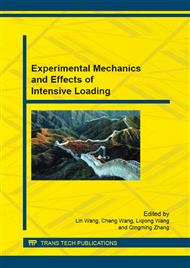p.183
p.197
p.204
p.210
p.219
p.227
p.237
p.245
p.252
Investigation of the Large Scale Borehole Soundless Cracking Experiment on the Concrete Members
Abstract:
In this paper, by the large scale borehole soundless cracking method, the fracture experiments were performed on the plain concrete and reinforced concrete. For plain concrete experiment, the open borehole was prefabricated in the concrete pillar at first. Secondly, two non-woven fabric bags contained soundless cracking agent were prepared, one for the main expanding and the other for blocking. Thirdly, the main expanding bag was plugged, and then the blocking bag. At last, the cracks in the concrete pillar were developed within 3 hours. For reinforced concrete experiment, the closed boreholes were prefabricated in the concrete beam. First the strain gauges were pasted on the designed locations of the stirrups. Secondly, the boreholes were filled with expanding grout and closed by the flange. The beam was cracked afterwards, and the strain was measured by the test system. It is proved that the large scale borehole soundless cracking method on the concrete members is practicable.
Info:
Periodical:
Pages:
219-226
Citation:
Online since:
August 2015
Keywords:
Price:
Сopyright:
© 2015 Trans Tech Publications Ltd. All Rights Reserved
Share:
Citation:


